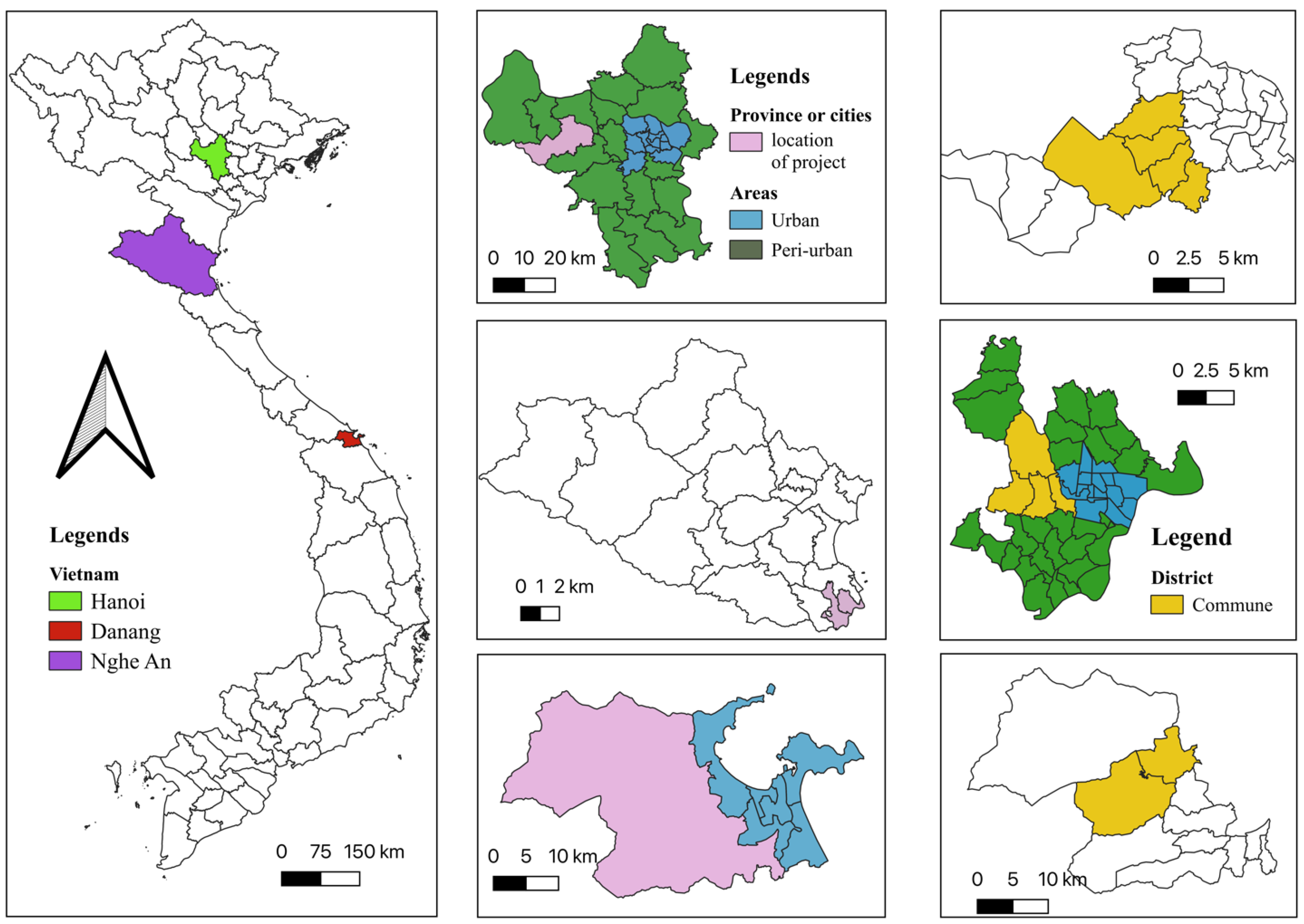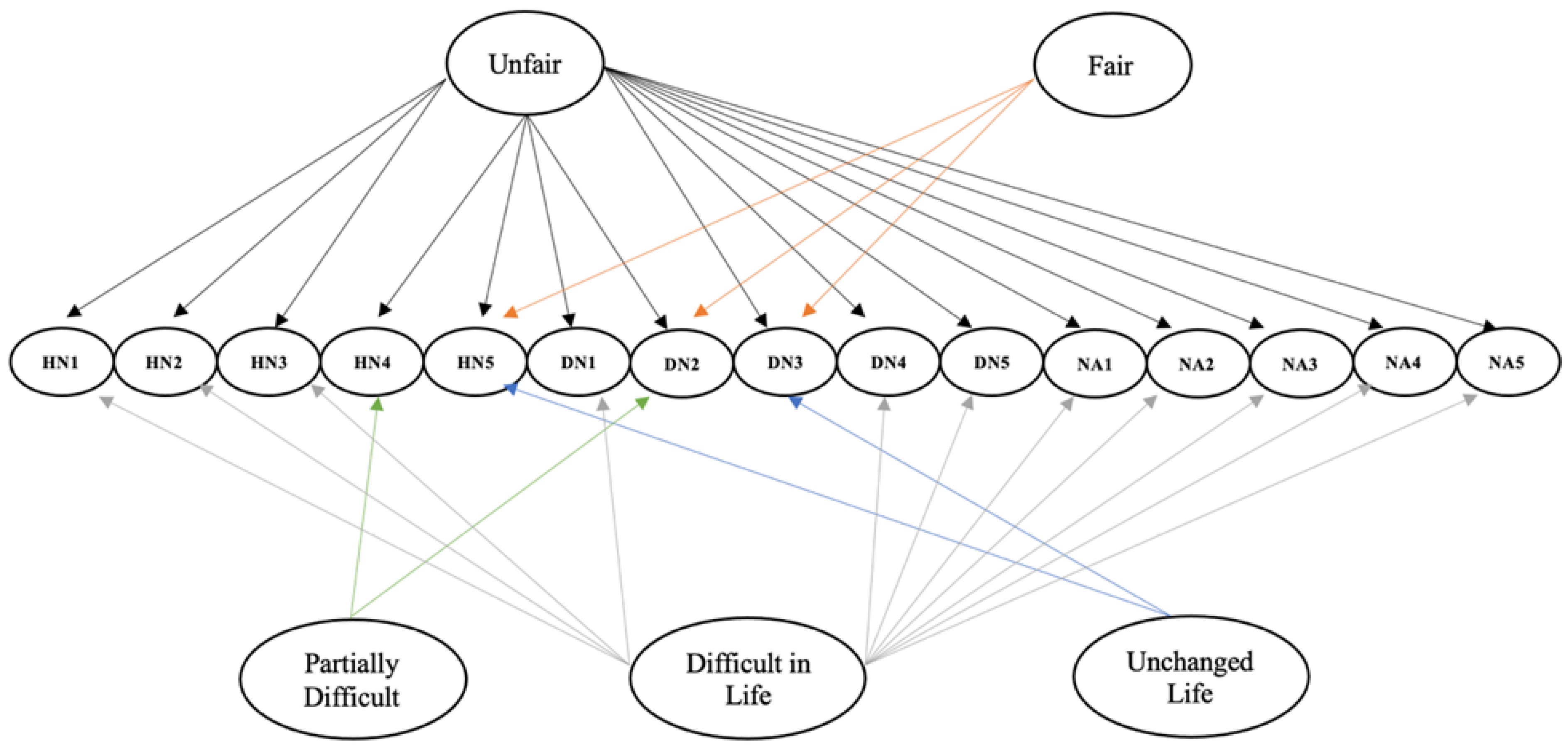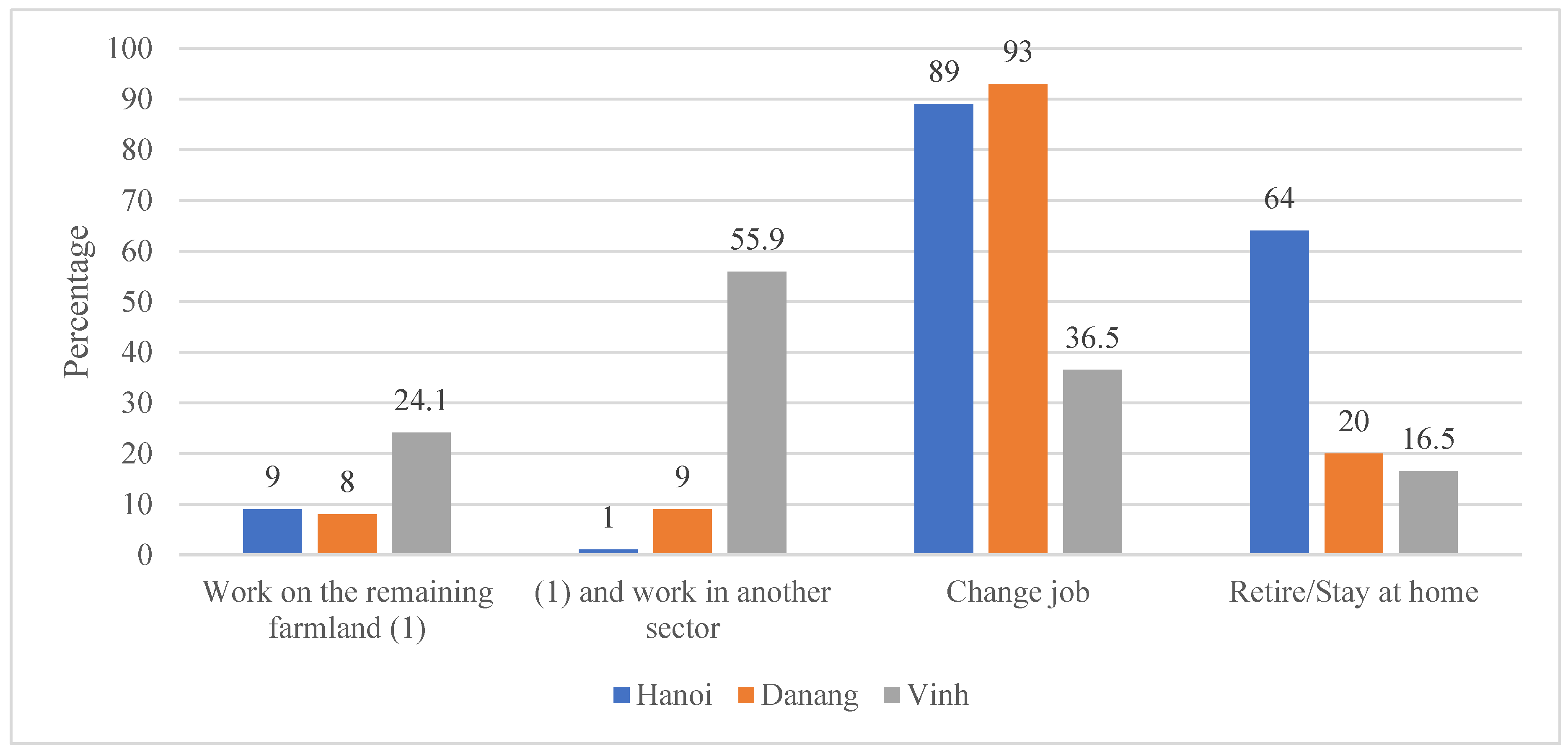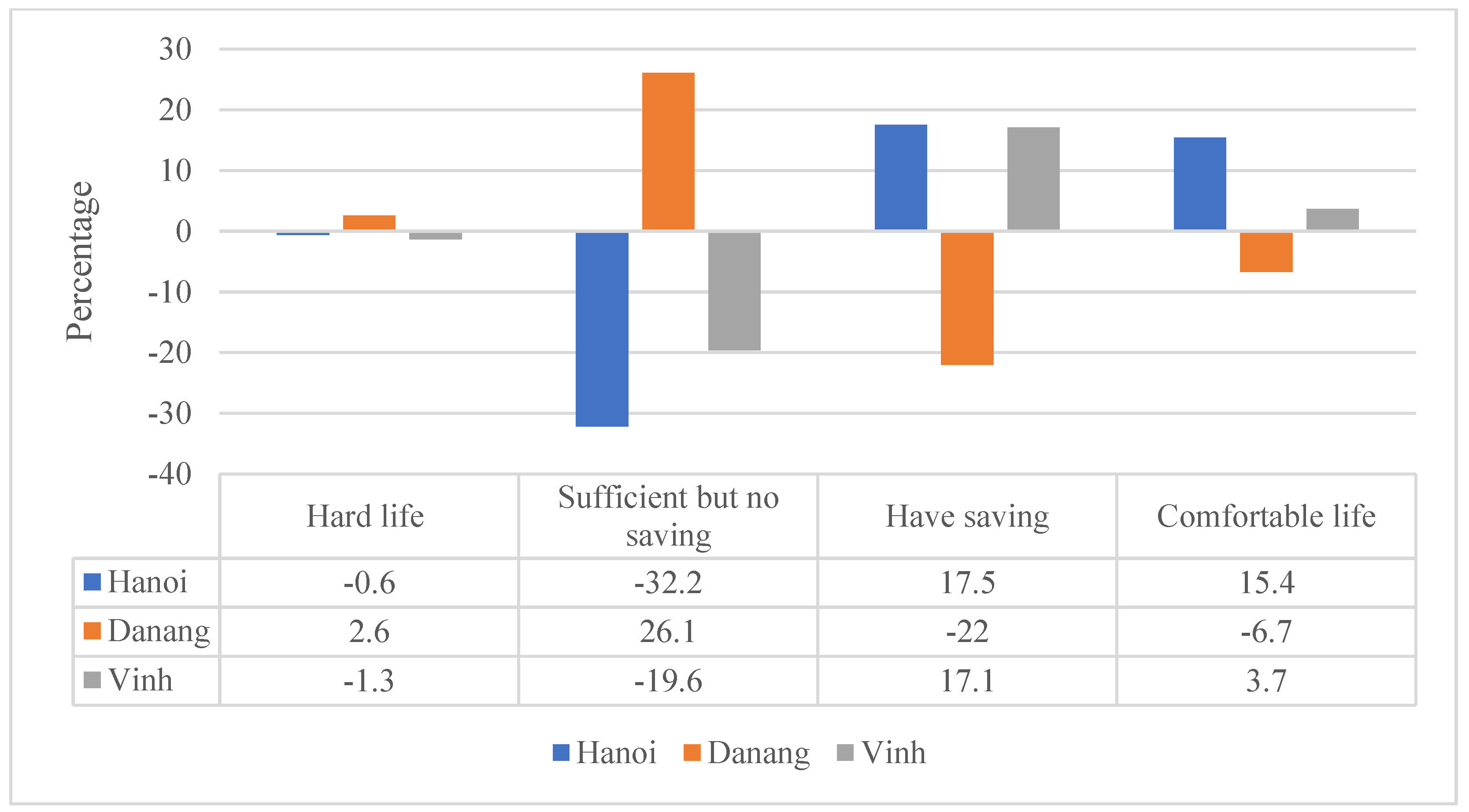Urbanization and Post-Acquisition Livelihood in a Peri-Urban Context in Vietnam: A Geographical Comparison between Hanoi, Danang, and Vinh City
Abstract
1. Introduction
- What are the key differences in the way that land acquisition and compensation policies are put into practice?
- How does land acquisition affect livelihood, employment, and income?
- How much compensation do families receive, and how do they use land acquisition compensation money?
- How does the quality of life alter with the purchase of something in the context of the framework for a sustainable livelihood?
2. Literature Review of Urban Characteristics and Division in Vietnam
2.1. Urban Characteristics
2.2. Urban Division in Vietnam
3. Research Areas and Methodology
3.1. Research Areas
3.2. Data Collection and Research Design
4. Results
4.1. Implementation of Land Acquisition and Compensation Policy
4.2. Changes in Income and Employment after Land Acquisition
4.3. Use of Compensation Money and Life Changes after Land Acquisition
5. Discussion
6. Conclusions
Author Contributions
Funding
Institutional Review Board Statement
Informed Consent Statement
Data Availability Statement
Acknowledgments
Conflicts of Interest
| 1 | This is the definition used in Vietnam to represent a form of urbanization. It is the city’s development due to the excessive increase in urban population and the arrival of people from other regions, especially rural areas, which leads to unemployment and a reduced quality of life. |
References
- Range, U.; Groth, K. A Conceptual Framework for Sustainable Urban Development. SKL International. 2012. Available online: https://www.diva-portal.org/smash/get/diva2:1445800/FULLTEXT01.pdf (accessed on 13 July 2021).
- Han, R.; Wang, L. Challenges and Opportunities Facing China’s Urban Development in the New Era. China Perspect. 2013, 2013, 15–27. [Google Scholar] [CrossRef][Green Version]
- Goi, C.L. The impact of technological innovation on building a sustainable city. Int. J. Qual. Innov. 2017, 3, 6. [Google Scholar] [CrossRef]
- Tacoli, C. The links between urban and rural development. Environ. Urban. 2003, 15, 3–12. [Google Scholar] [CrossRef]
- Kalantari, Z.; Ferreira, C.S.S.; Page, J.; Goldenberg, R.; Olsson, J.; Destouni, G. Meeting sustainable development challenges in growing cities: Coupled social-ecological systems modeling of land use and water changes. J. Environ. Manag. 2019, 245, 471–480. [Google Scholar] [CrossRef] [PubMed]
- Keivani, R. A review of the main challenges to urban sustainability. Int. Urban Sustain. Dev. 2010, 1, 5–16. [Google Scholar] [CrossRef]
- Hilmi, M.; Bradbear, N.; Meija, D. Beekeeping and sustainable livelihoods. In FAO Deversification Booklet; Food and Agriculture Organization of the United Nations (FAO): Rome, Italy, 2011. [Google Scholar]
- Chambers, R.; Conway, G. Sustainable Rural Livelihoods: Practical Concepts for the 21st Century; IDS Discussion Paper 296; Institute of Development Studies: Brighton, UK, 1992. [Google Scholar]
- Krantz, L. The Sustainable Livelihood Approach to Poverty Reduction: An Introduction. Swedish International Development Cooperation Agency. 2001. Available online: https://publikationer.sida.se/contentassets/bd474c210163447c9a7963d77c64148a/the-sustainable-livelihood-approach-to-poverty-reduction_2656.pdf (accessed on 14 July 2021).
- Carswell, G. Agricultural Intensification and Rural Sustainable Livelihoods: A “Think Piece”; IDS Working Paper 64; Institute of Development Studies: Brighton, UK, 1997. [Google Scholar]
- Hussein, K.; Nelson, J. Sustainable Livelihoods and Livelihood Diversification; IDS Working Paper 69; Institute of Development Studies: Brighton, UK, 1998. [Google Scholar]
- Scoones, I. Sustainable Rural Livelihoods: A Framework for Analysis; IDS Working Paper 72; Institute of Development Studies: Brighton, UK, 1998. [Google Scholar]
- Valdés-Rodríguez, O.A.; Pérez-Vázquez, A. Sustainable Livelihoods: An Analysis of The Methodology. Trop. Subtrop. Agroecosyst. 2011, 14, 91–99. [Google Scholar]
- Nguyen, T.T.; Hegedus, G.; Nguyen, T.L. Effect of Land Acquisition and Compensation on the Livelihoods of People in Quang Ninh District, Quang Binh Province: Labor and Income. Land 2019, 8, 91. [Google Scholar] [CrossRef]
- Hai, Y.H.P.; Vinh, L.T.T.; Tuyen, T.T.; Hoai, N.T.; Thanh, N.T.T.; Nguyen, T.T. Development Sustainable Livelihoods for Fishmen in the North Central Region of Vietnam—Case Study for Nghe An Province. J. Agric. Stud. 2020, 8, 227–246. [Google Scholar] [CrossRef]
- Nguyen, T.T. Conversion of land use and household livelihoods in Vietnam: A study in Nghe An. Open Agric. 2021, 6, 82–92. [Google Scholar] [CrossRef]
- Tuan, N.T. The consequences of expropriation of agricultural land and loss of livelihoods on those households who lost land in Danang, Vietnam. Environ. Socio-Econ. Stud. 2021, 9, 26–38. [Google Scholar] [CrossRef]
- Chaolin, G. Urbanization. In International Encyclopedia of Human Geography; Elsevier: Amsterdam, The Netherlands, 2020; pp. 141–153. [Google Scholar] [CrossRef]
- Dieu, P.Q. Agriculture Sector of Vietnam Policies and Performance. I International Congress on Human Development MADRID 2006. Available online: http://www.reduniversitaria.es/ficheros/Pham%20Quang%20Dieu.pdf (accessed on 14 July 2021).
- World Bank. Urban Population (% of Total Population). 2022. Available online: https://data.worldbank.org/indicator/SP.URB.TOTL.IN.ZS?locations=VN (accessed on 21 August 2022).
- General Statistics Office of Vietnam (GSO). Completed Results of the 2019 Vietnam Population and Housing Census; GSO: Ha Noi, Vietnam, 2020.
- Kim, T.J.; Claus, M.; Rank, J.S.; Xiao, Y. Technology and Cities: Processes of Technology-Land Substitution in the Twentieth Century. J. Urban Technol. 2009, 16, 63–89. [Google Scholar] [CrossRef]
- Scott, A.J. Capitalism and Urbanization in a New Key? The Cognitive-Cultural Dimension. Soc. Forces 2007, 85, 1465–1482. [Google Scholar] [CrossRef]
- World Bank. Vietnam Urbanization Review: Technical Assistance Report. 2011. Available online: http://documents1.worldbank.org/curated/en/225041468177548577/pdf/669160ESW0P1130Review000Full0report.pdf (accessed on 20 July 2021).
- Quertamp, F.; De Miras, C. Periurbanization and governance of large metropolises in Vietnam. In Trends of Urbanization and Suburbanization in Southeast Asia; Ho Chi Minh City General Publishing House: Ho Chi Minh City, Vietnam, 2012; Available online: https://horizon.documentation.ird.fr/exl-doc/pleins_textes/divers12-08/010055229.pdf (accessed on 20 July 2021).
- Bui, T.P.; Imai, K.S. Determinants of Rural-Urban Inequality in Vietnam: Detailed Decomposition Analyses Based on Unconditional Quantile Regressions. J. Dev. Stud. 2018, 55, 2610–2625. [Google Scholar] [CrossRef]
- Laquian, A.A. The Planning and Governance of Asia’s Mega-Urban Regions. In Proceedings of the United Nations Expert Group Meeting on Population Distribution, Urbanization, Internal Migration and Development, New York, NY, USA, 21–23 January 2008; Available online: https://www.un.org/en/development/desa/population/events/pdf/expert/13/P04_Laquian.pdf (accessed on 18 July 2021).
- Nga, T. Tỷ lệ đô thị hoá toàn quốc tăng 0.6% (National Urbanization Rate Increased 0.6%). Tạp chí xây dựng—tạp chí điện tử của Bộ Xây dựng (Construction Magazine—Electronic Magazine of the Ministry of Construction). 2022. Available online: https://tapchixaydung.vn/ty-le-do-thi-hoa-toan-quoc-tang-06-20201224000011705.html (accessed on 20 July 2022).
- Leducq, D.; Scarwell, H.-J. The new Hanoi: Opportunities and challenges for future urban development. Cities 2018, 72, 70–81. [Google Scholar] [CrossRef]
- Huynh, D. The misuse of urban planning in Ho Chi Minh City. Habitat Int. 2015, 48, 11–19. [Google Scholar] [CrossRef]
- Coxhead, I.; Cuong, N.V.; Vu, L.H. Migration in Vietnam: New Evidence from Recent Surveys; Vietnam Development Economics Discussion Paper; World Bank: Washington, DC, USA, 2015. [Google Scholar]
- Lam, V.T.; Hang, N.T.D. Phát triển đô thị ở Việt Nam hướng tới mục tiêu đến năm 2030, tầm nhìn đến 2045 (Urban Development in Vietnam towards 2030, Vision to 2045). Tạp chí Cộng sản (Communist Magazine). 2021. Available online: https://www.tapchicongsan.org.vn/web/guest/tin-tieu-diem/-/asset_publisher/s5L7xhQiJeKe/content/phat-trien-do-thi-o-viet-nam-huong-toi-muc-tieu-den-nam-2030-tam-nhin-den-nam-2045 (accessed on 20 July 2022).
- Pulliat, G. Food securitization and urban agriculture in Hanoi (Vietnam). J. Urban Res. 2015, 7, 2845. [Google Scholar] [CrossRef]
- Bangkok Post. Danang: The Most Livable City in Vietnam. 2018. Available online: https://www.bangkokpost.com/travel/1547078/da-nang-the-most-livable-city-in-vietnam (accessed on 27 August 2021).
- Da Nang City Portal, 2020. Dân số (Population). Available online: https://danang.gov.vn/web/guest/gioi-thieu/chi-tiet?id=40958&_c=40 (accessed on 27 August 2021).
- Nguyen, T.T.; Hegedus, G. Land acquisition under Land Law 2013: A case study of Vinh City, Nghe an province. Adv. Southeast Asian Stud. 2022, 15, 103–123. [Google Scholar] [CrossRef]
- Thoburn, J. Vietnam as A Role Model for Development; Research Paper No. 2009/30; UNU-WIDER: Helsinki, Finland, 2009. [Google Scholar] [CrossRef]
- Nguyen, H.L.; Duan, J.; Liu, J.H. State Control Versus Hybrid Land Markets: Planning and Urban Development in Transitional Hanoi, Vietnam. Sustainability 2018, 10, 2993. [Google Scholar] [CrossRef]
- Nguyen, L. Chapter 5—An overview of the Vietnamese economy in transition and the reform of state-owned enterprises. In Guerilla Capitalism: The State in the Market in Vietnam; Chandos Asian Studies Series; Elsevier: Amsterdam, The Netherlands, 2009. [Google Scholar] [CrossRef]
- Ariff, M.; Cheen, L.C. Mobilizing Domestic and External Resources for Economic Development: Lessons from the Malaysian Experience. Asia-Pac. Dev. J. 2001, 8, 41–68. [Google Scholar]
- Tran Tuan, N. Shrinking agricultural land and changinf livelihoods after land acquisition in Vietnam. Bull. Geogr. Socio-Econ. Ser. 2021, 53, 17–32. [Google Scholar] [CrossRef]
- Jiang, K.; Lepak, D.P.; Hu, J.; Baer, J.C. How Does Human Resource Management Influence Organizational Outcomes? A Meta-Analytic Investigation of Mediating Mechanisms. Acad. Manag. J. 2012, 55, 1264–1294. [Google Scholar] [CrossRef]
- World Bank. Vibrant Vietnam: Forging the Foundation of a High-Income Economy. In Australia-World Bank Group Strategic Partnership in Vietnam, Vietnam 2035: From Strategy to Action; World Bank: Washington, DC, USA, 2020; Available online: http://documents1.worldbank.org/curated/en/745271590429811414/pdf/Main-Report.pdf (accessed on 20 August 2021).
- Giesecke, J.A.; Tran, N.H.; Meagher, G.A.; Pang, F. Growth and Change in the Vietnamese Labour Market: A decomposition of forecast trends in employment over 2010–2020. In Proceedings of the 14th Annual Conference on Global Economic Analysis, Ca’Foscari University of Venice, Venice, Italy, 16–18 June 2011. [Google Scholar]
- McGuinness, S.; Kelly, E.; Phuong, P.T.T.; Thuy, H.T.T. Returns to Education and the Demand for Labour in Vietnam; ESRI Working Paper, No. 506; The Economic and Social Research Institute (ESRI): Dublin, Ireland, 2015. [Google Scholar]
- World Bank. Vietnam’s Future Jobs: Leveraging Mega-Trends For Greater Prosperity; Hong Duc Publishing House: Hanoi, Vietnam, 2018. [Google Scholar]
- Tuan, N.T.; Hegedűs, G. Land compensation and policy enforcement in Vietnam: A case study in Danang. Real Estate Manag. Valuat. 2018, 30, 34–46. [Google Scholar] [CrossRef]
- Arimah, B. Infrastructure as a Catalyst for the Prosperity of African Cities. Procedia Eng. 2017, 198, 245–266. [Google Scholar] [CrossRef]
- World Bank; Government of Vietnam. Vietnam Public Expenditure Review: Fiscal Policies towards: Sustainability, Efficiency, and Equity. 2017. Available online: http://documents1.worldbank.org/curated/en/156711508765460281/pdf/120605-PER-v1-PUBLIC-44p-VietnamPublicExpenditureReviewSummaryReportEN.pdf (accessed on 18 August 2021).
- Ironmonger, D. Household Production. In International Encyclopedia of the Social & Behavioral Sciences; Elsevier: Amsterdam, The Netherlands, 2001; pp. 6934–6939. [Google Scholar] [CrossRef]
- Bhandari, H.; Yasunobu, K. What is Social Capital? A Comprehénive Review of the Concept. Asian J. Soc. Sci. 2009, 37, 480–510. [Google Scholar] [CrossRef]
- Kurt, R. Industry 4.0 in Terms of Industrial Relations and Its Impacts on Labour Life. Procedia Comput. Sci. 2019, 158, 590–601. [Google Scholar] [CrossRef]
- Curtiss, J. Determinants of Financial Capital Use: Review of Theories and Implications for Rural Businesses; Factor Markets Working Paper No. 19. Centre for European Policy Studies: Brussels, Belgium, 2012. Available online: https://doi.org/10.22004/ag.econ.122846 (accessed on 21 August 2022).






| No | Urban Types | Evaluation Criteria | ||||
|---|---|---|---|---|---|---|
| Functions | Population | Non-Agri Employees | ||||
| Size | Density | |||||
| 1 | Special Urban | This national center promotes socioeconomic development. | >5 million people | >3000 people per km2 | per whole urban > 70% | |
| 2 | Urban Type I | Under Central Areas | This national, regional, or provincial center promotes interprovincial or national socioeconomic growth. | >1 million people | >2000 people per km2 | per whole urban > 65% |
| Under Province | >500,000 people | |||||
| 3 | Urban Type II | This is a regional or provincial center that promotes inter-provincial socio-economic development. | >200,000 people | 1800 people per km2 | per whole urban > 65% | |
| 4 | Urban Type III | This is a center that supports the province’s socioeconomic growth or interprovincial region. | >100,000 people | 1400 people per km2 | per whole urban > 60% | |
| 5 | Urban Type IV | This is a provincial or district general or specialized center that promotes socio-economic development. | >50,000 people | 1200 people per km2 | per whole urban > 55% | |
| 6 | Urban Type V | This district-level general administrative center promotes socio-economic development of the inter-population cluster. | >4000 people | 1000 people per km2 | per whole urban > 55% | |
| Questionnaire | Interview | ||||
|---|---|---|---|---|---|
| Expert | Investor | Local Authority | Households (Not on the List of Acquisitions) | ||
| Vinh | 170 | 2 | 1 | 2 | 5 |
| Danang | 100 | 2 | 1 | 2 | 5 |
| Hanoi | 100 | 2 | 1 | 2 | 5 |
| Total | 370 | 6 | 3 | 6 | 15 |
| Categories | Hanoi | Danang | Vinh | ||||
|---|---|---|---|---|---|---|---|
| Freq. | Percent | Freq. | Percent | Freq. | Percent | ||
| Compensation agreement | Yes | 2 | 2.0 | 80 | 80.0 | 138 | 81.2 |
| No | 96 | 96.0 | 20 | 20.0 | 30 | 17.6 | |
| Others | 2 | 2.0 | 0 | 0 | 2 | 1.2 | |
| Total | 100 | 100.0 | 100 | 100.0 | 170 | 100.0 | |
| Full compensation for damages | Yes | 39 | 39.0 | 38 | 38.0 | 166 | 97.6 |
| Nothing | 44 | 44.0 | 55 | 55.0 | 3 | 1.8 | |
| Not fulfilling promise | 17 | 17.0 | 7 | 7.0 | 1 | 0.6 | |
| Total | 100 | 100.0 | 100 | 100.0 | 170 | 100.0 | |
| Households’ assessment | Opposite | 1 | 1.0 | 1 | 1.0 | 5 | 2.9 |
| Disagree | 49 | 49.0 | 15 | 15.0 | 19 | 11.2 | |
| Agree but dissatisfied | 43 | 43.0 | 44 | 44.0 | 81 | 47.6 | |
| Satisfied but price discrepancy | 4 | 4.0 | 20 | 20.0 | 35 | 20.6 | |
| Completely agree | 3 | 3.0 | 20 | 20.0 | 30 | 17.6 | |
| Total | 100 | 100.0 | 100 | 100.0 | 170 | 100.0 | |
| Employment | Income | ||||
|---|---|---|---|---|---|
| Number (Person) | Percent (%) | Number (USD) | Percent (%) | ||
| Hanoi | Before | 286 | 100% | 456,378.4 | 100% |
| After | 286 | 100% | 608,151.9 | 133.3% | |
| Danang | Before | 256 | 100% | 503,786.6 | 100% |
| After | 229 | 89.5% | 485,405.2 | 96.4% | |
| Vinh | Before | 553 | 100% | 853,073.1 | 100% |
| After | 427 | 77.2% | 1,008,079.1 | 118.2% | |
| Categories | Hanoi (%) | Danang (%) | Vinh (%) | |
|---|---|---|---|---|
| I. Assets | House repairs | 57 | 81 | 44.1 |
| Motorbike | 14 | 20 | 8.2 | |
| Dept repayment | 8 | 24 | 30.6 | |
| II. Investments | Grocery store | 3 | 15 | 7.1 |
| Agri-machines | 0 | 1 | 0% | |
| Flat for rent | 0 | 1 | 0.6 | |
| Depositing all money for interest | 1 | 10 | 12.4 | |
| Deposit remaining money | 10 | 34 | 14.1 | |
| Invest for children | 35 | 21 | 51.8 | |
Publisher’s Note: MDPI stays neutral with regard to jurisdictional claims in published maps and institutional affiliations. |
© 2022 by the authors. Licensee MDPI, Basel, Switzerland. This article is an open access article distributed under the terms and conditions of the Creative Commons Attribution (CC BY) license (https://creativecommons.org/licenses/by/4.0/).
Share and Cite
Tuan, N.T.; Hegedűs, G. Urbanization and Post-Acquisition Livelihood in a Peri-Urban Context in Vietnam: A Geographical Comparison between Hanoi, Danang, and Vinh City. Land 2022, 11, 1787. https://doi.org/10.3390/land11101787
Tuan NT, Hegedűs G. Urbanization and Post-Acquisition Livelihood in a Peri-Urban Context in Vietnam: A Geographical Comparison between Hanoi, Danang, and Vinh City. Land. 2022; 11(10):1787. https://doi.org/10.3390/land11101787
Chicago/Turabian StyleTuan, Nguyen Tran, and Gábor Hegedűs. 2022. "Urbanization and Post-Acquisition Livelihood in a Peri-Urban Context in Vietnam: A Geographical Comparison between Hanoi, Danang, and Vinh City" Land 11, no. 10: 1787. https://doi.org/10.3390/land11101787
APA StyleTuan, N. T., & Hegedűs, G. (2022). Urbanization and Post-Acquisition Livelihood in a Peri-Urban Context in Vietnam: A Geographical Comparison between Hanoi, Danang, and Vinh City. Land, 11(10), 1787. https://doi.org/10.3390/land11101787








